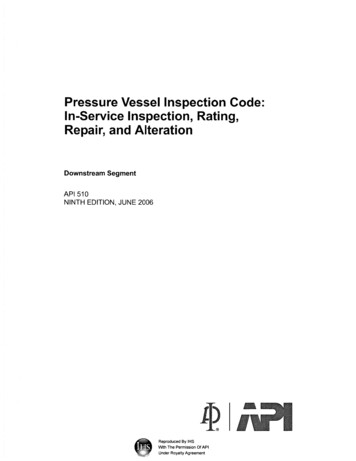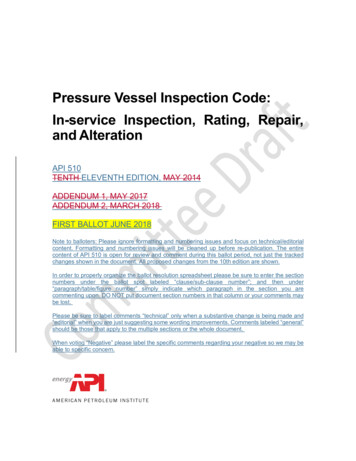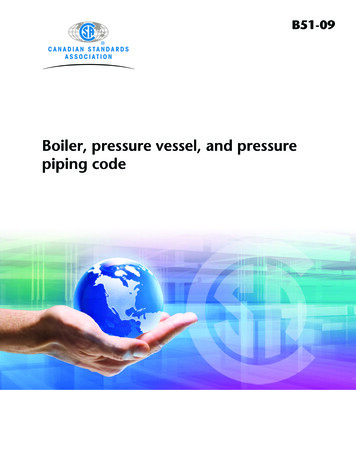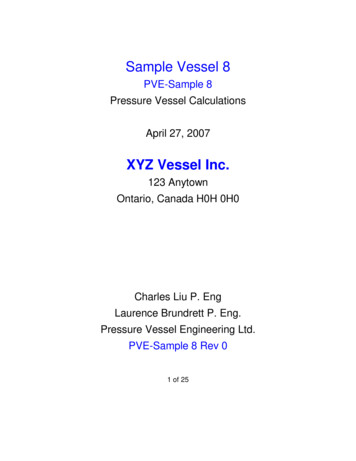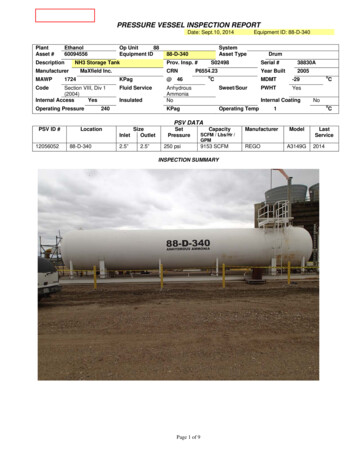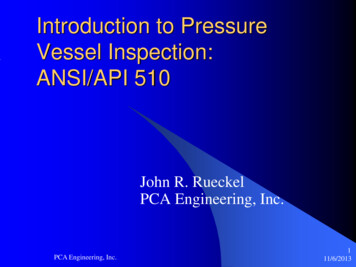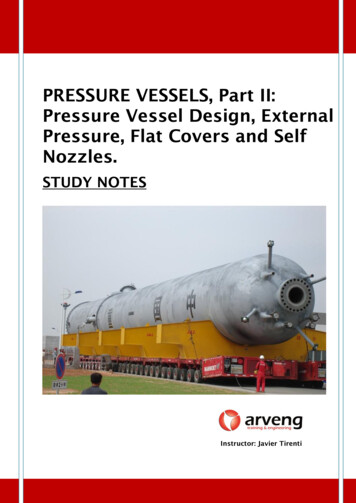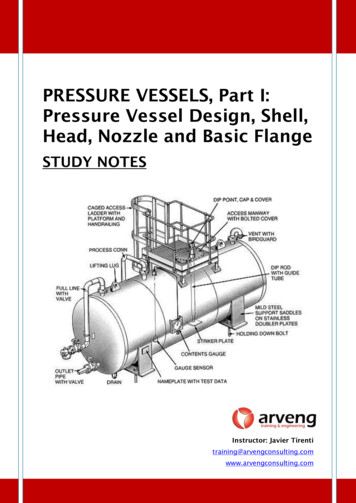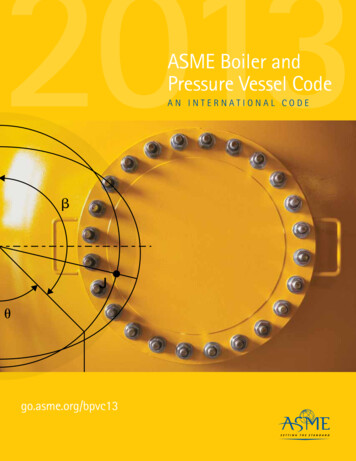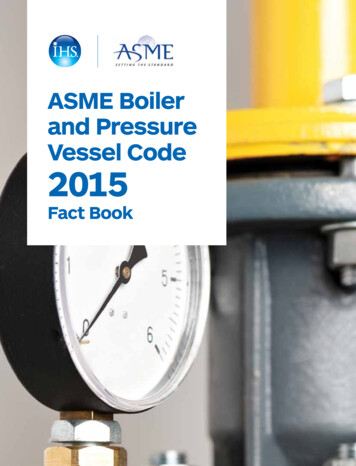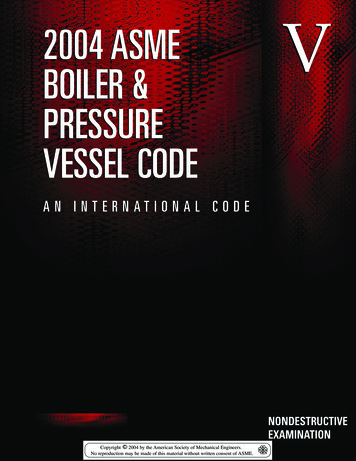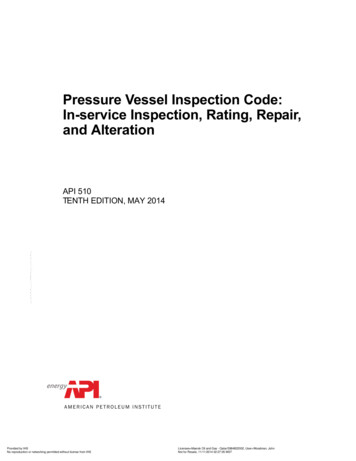
Transcription
Pressure Vessel Inspection Code:In-service Inspection, Rating, Repair,and AlterationAPI 510TENTH EDITION, MAY 2014-- ,, ,, , , , , ,, ,,,,, , - - ,, ,, , ,, ---Provided by IHSNo reproduction or networking permitted without license from IHSLicensee Maersk Oil and Gas - Qatar/5964822002, User Woodman, JohnNot for Resale, 11/11/2014 02:27:05 MST
Special NotesAPI publications necessarily address problems of a general nature. With respect to particular circumstances, local,state, and federal laws and regulations should be reviewed.Neither API nor any of API's employees, subcontractors, consultants, committees, or other assignees make anywarranty or representation, either express or implied, with respect to the accuracy, completeness, or usefulness of theinformation contained herein, or assume any liability or responsibility for any use, or the results of such use, of anyinformation or process disclosed in this publication. Neither API nor any of API's employees, subcontractors,consultants, or other assignees represent that use of this publication would not infringe upon privately owned rights.API publications may be used by anyone desiring to do so. Every effort has been made by the Institute to assure theaccuracy and reliability of the data contained in them; however, the Institute makes no representation, warranty, orguarantee in connection with this publication and hereby expressly disclaims any liability or responsibility for loss ordamage resulting from its use or for the violation of any authorities having jurisdiction with which this publication mayconflict.API publications are published to facilitate the broad availability of proven, sound engineering and operatingpractices. These publications are not intended to obviate the need for applying sound engineering judgmentregarding when and where these publications should be utilized. The formulation and publication of API publicationsis not intended in any way to inhibit anyone from using any other practices.Any manufacturer marking equipment or materials in conformance with the marking requirements of an API standardis solely responsible for complying with all the applicable requirements of that standard. API does not represent,warrant, or guarantee that such products do in fact conform to the applicable API standard.Users of this Standard should not rely exclusively on the information contained in this document. Sound business,scientific, engineering, and safety judgment should be used in employing the information contained herein.Work sites and equipment operations may differ. Users are solely responsible for assessing their specific equipmentand premises in determining the appropriateness of applying the Standard. At all times users should employ soundbusiness, scientific, engineering, and judgment safety when using this Standard.-- ,, ,, , , , , ,, ,,,,, , - - ,, ,, , ,, ---All rights reserved. No part of this work may be reproduced, translated, stored in a retrieval system, or transmitted by any means,electronic, mechanical, photocopying, recording, or otherwise, without prior written permission from the publisher. Contact thePublisher, API Publishing Services, 1220 L Street, NW, Washington, DC 20005.Provided by IHSNo reproduction or networking permitted without license from IHSCopyright 2014 American Petroleum InstituteLicensee Maersk Oil and Gas - Qatar/5964822002, User Woodman, JohnNot for Resale, 11/11/2014 02:27:05 MST
ForewordIn December 1931, API and the American Society of Mechanical Engineers (ASME) created the Joint API/ASMECommittee on Unfired Pressure Vessels. This committee was created to formulate and prepare for publication a codefor safe practices in the design, construction, inspection, and repair of pressure vessels to be used in the petroleumindustry. Entitled API/ASME Code for Unfired Pressure Vessels for Petroleum Liquids and Gases (commonly calledthe API/ASME Code for Unfired Pressure Vessels or API/ASME Code), the First Edition of the API/ASME Code wasapproved for publication in 1934. From its inception, the API/ASME Code contained Section I, which coveredrecommended practices for vessel inspection and repair and for establishing allowable working pressures for vesselsin service. Section I recognized and afforded well-founded bases for handling various problems associated with theinspection and rating of vessels subject to corrosion. Although the provisions of Section I (like other parts of the API/ASME Code) were originally intended for pressure vessels installed in the plants of the petroleum industry, especiallythose vessels containing petroleum gases and liquids, these provisions were actually considered to be applicable topressure vessels in most services. ASME’s Boiler and Pressure Vessel Committee adopted substantially identicalprovisions and published them as a nonmandatory appendix in the 1950, 1952, 1956, and 1959 editions of SectionVIII of the ASME Boiler and Pressure Vessel Code.After the API/ASME Code was discontinued in 1956, a demand arose for the issuance of Section I as a separatepublication, applicable not only to vessels built in accordance with any edition of the API/ASME Code but also tovessels built in accordance with any edition of Section VIII of the API/ASME Code. Such a publication appeared to benecessary to assure industry that the trend toward uniform maintenance and inspection practices afforded bySection I of the API/ASME Code would be preserved. API 510, first published in 1958, is intended to satisfy this need.The procedures in Section I of the 1951 edition of the API/ASME Code, as amended by the March 16, 1954addendum, have been updated and revised in API 510. Section I of the API/ASME Code contained references tocertain design or construction provisions, so these references have been changed to refer to provisions in the API/ASME Code. Since the release of the 1960 edition of the National Board Inspection Code, elements of the API/ASMECode have also been carried by the National Board Inspection Code.It is the intent of API to keep this publication up to date. All pressure vessel owners and operators are invited to reporttheir experiences in the inspection and repair of pressure vessels whenever such experiences may suggest a needfor revising or expanding the practices set forth in API 510.This edition of API 510 supersedes all previous editions of API 510. Each edition, revision, or addendum to this APIcode may be used beginning with the date of issuance shown on the cover page for that edition, revision, oraddendum. Each edition, revision, or addendum to this API code becomes effective six months after the date ofissuance for equipment that is rerated, reconstructed, relocated, repaired, modified (altered), inspected, and testedper this code. During the six-month time between the date of issuance of the edition, revision, or addendum and theeffective date, the user shall specify to which edition, revision, or addendum the equipment is to be rerated,reconstructed, relocated, repaired, modified (altered), inspected, and tested.Nothing contained in any API publication is to be construed as granting any right, by implication or otherwise, for themanufacture, sale, or use of any method, apparatus, or product covered by letters patent. Neither should anythingcontained in the publication be construed as insuring anyone against liability for infringement of letters patent.Shall: As used in a standard, “shall” denotes a minimum requirement in order to conform to the specification.Should: As used in a standard, “should” denotes a recommendation or that which is advised but not required in orderto conform to the specification.This document was produced under API standardization procedures that ensure appropriate notification andparticipation in the developmental process and is designated as an API standard. Questions concerning theinterpretation of the content of this publication or comments and questions concerning the procedures under which-- ,, ,, , , , , ,, ,,,,, , - - ,, ,, , ,, ---Provided by IHSNo reproduction or networking permitted without license from IHSiiiLicensee Maersk Oil and Gas - Qatar/5964822002, User Woodman, JohnNot for Resale, 11/11/2014 02:27:05 MST
this publication was developed should be directed in writing to the Director of Standards, American PetroleumInstitute, 1220 L Street, NW, Washington, DC 20005. Requests for permission to reproduce or translate all or any partof the material published herein should also be addressed to the Director.Generally, API standards are reviewed and revised, reaffirmed, or withdrawn at least every five years. A one-timeextension of up to two years may be added to this review cycle. Status of the publication can be ascertained from theAPI Standards Department, telephone (202) 682-8000. A catalog of API publications and materials is publishedannually by API, 1220 L Street, NW, Washington, DC 20005.Suggested revisions are invited and should be submitted to the Standards Department, API, 1220 L Street, NW,Washington, DC 20005, standards@api.org.-- ,, ,, , , , , ,, ,,,,, , - - ,, ,, , ,, ---Provided by IHSNo reproduction or networking permitted without license from IHSivLicensee Maersk Oil and Gas - Qatar/5964822002, User Woodman, JohnNot for Resale, 11/11/2014 02:27:05 MST
ContentsPage-- ,, ,, , , , , ,, ,,,,, , - - ,, ,, , ,, ---11.11.21.3Scope . . . . . . . . . . . . . . . . . . . . . . . . . . . . . . . . . . . . . . . . . . . . . . . . . . . . . . . . . . . . . . . . . . . . . . . . . . . . . . . . . .General Application. . . . . . . . . . . . . . . . . . . . . . . . . . . . . . . . . . . . . . . . . . . . . . . . . . . . . . . . . . . . . . . . . . . . . . .Specific Applications . . . . . . . . . . . . . . . . . . . . . . . . . . . . . . . . . . . . . . . . . . . . . . . . . . . . . . . . . . . . . . . . . . . . .Recognized Technical Concepts . . . . . . . . . . . . . . . . . . . . . . . . . . . . . . . . . . . . . . . . . . . . . . . . . . . . . . . . . . . .2Normative References. . . . . . . . . . . . . . . . . . . . . . . . . . . . . . . . . . . . . . . . . . . . . . . . . . . . . . . . . . . . . . . . . . . . . 233.13.2Terms, Definitions, Acronyms, and Abbreviations . . . . . . . . . . . . . . . . . . . . . . . . . . . . . . . . . . . . . . . . . . . . . 4Terms and Definitions . . . . . . . . . . . . . . . . . . . . . . . . . . . . . . . . . . . . . . . . . . . . . . . . . . . . . . . . . . . . . . . . . . . . . 4Acronyms and Abbreviations . . . . . . . . . . . . . . . . . . . . . . . . . . . . . . . . . . . . . . . . . . . . . . . . . . . . . . . . . . . . . 1344.14.24.34.44.54.64.7Owner/User Inspections Organization . . . . . . . . . . . . . . . . . . . . . . . . . . . . . . . . . . . . . . . . . . . . . . . . . . . . . .Owner/User Organization Responsibilities . . . . . . . . . . . . . . . . . . . . . . . . . . . . . . . . . . . . . . . . . . . . . . . . . .Engineer . . . . . . . . . . . . . . . . . . . . . . . . . . . . . . . . . . . . . . . . . . . . . . . . . . . . . . . . . . . . . . . . . . . . . . . . . . . . . . .Repair Organization. . . . . . . . . . . . . . . . . . . . . . . . . . . . . . . . . . . . . . . . . . . . . . . . . . . . . . . . . . . . . . . . . . . . . .Inspector. . . . . . . . . . . . . . . . . . . . . . . . . . . . . . . . . . . . . . . . . . . . . . . . . . . . . . . . . . . . . . . . . . . . . . . . . . . . . . .Examiners. . . . . . . . . . . . . . . . . . . . . . . . . . . . . . . . . . . . . . . . . . . . . . . . . . . . . . . . . . . . . . . . . . . . . . . . . . . . . .Other Personnel. . . . . . . . . . . . . . . . . . . . . . . . . . . . . . . . . . . . . . . . . . . . . . . . . . . . . . . . . . . . . . . . . . . . . . . . .Inspection Organization Audits . . . . . . . . . . . . . . . . . . . . . . . . . . . . . . . . . . . . . . . . . . . . . . . . . . . . . . . . . . . .115.12Inspection, Examination, and Pressure Testing Practices. . . . . . . . . . . . . . . . . . . . . . . . . . . . . . . . . . . . . .Inspection Plans . . . . . . . . . . . . . . . . . . . . . . . . . . . . . . . . . . . . . . . . . . . . . . . . . . . . . . . . . . . . . . . . . . . . . . . .Risk-Based Inspection (RBI) . . . . . . . . . . . . . . . . . . . . . . . . . . . . . . . . . . . . . . . . . . . . . . . . . . . . . . . . . . . . . .Preparation for Inspection . . . . . . . . . . . . . . . . . . . . . . . . . . . . . . . . . . . . . . . . . . . . . . . . . . . . . . . . . . . . . . . .Inspection for Different Types of Damage Mechanisms and Failure Modes . . . . . . . . . . . . . . . . . . . . . . .Types of Inspection and Surveillance for Pressure Vessels . . . . . . . . . . . . . . . . . . . . . . . . . . . . . . . . . . . .Condition Monitoring Locations (CMLs) . . . . . . . . . . . . . . . . . . . . . . . . . . . . . . . . . . . . . . . . . . . . . . . . . . . .Condition Monitoring Methods . . . . . . . . . . . . . . . . . . . . . . . . . . . . . . . . . . . . . . . . . . . . . . . . . . . . . . . . . . . .Pressure Testing . . . . . . . . . . . . . . . . . . . . . . . . . . . . . . . . . . . . . . . . . . . . . . . . . . . . . . . . . . . . . . . . . . . . . . . .Material Verification and Traceability . . . . . . . . . . . . . . . . . . . . . . . . . . . . . . . . . . . . . . . . . . . . . . . . . . . . . . .Inspection of In-service Welds. . . . . . . . . . . . . . . . . . . . . . . . . . . . . . . . . . . . . . . . . . . . . . . . . . . . . . . . . . . . .Inspection and Repair of Flanged Joints . . . . . . . . . . . . . . . . . . . . . . . . . . . . . . . . . . . . . . . . . . . . . . . . . . . .Inspection of Shell and Tube Heat Exchangers . . . . . . . . . . . . . . . . . . . . . . . . . . . . . . . . . . . . . . . . . . . . . . .86.9Interval/Frequency and Extent of Inspection . . . . . . . . . . . . . . . . . . .
This edition of API 510 supersedes all previous editions of API 510. Each edition, revision, or addendum to this API code may be used beginning with the date File Size: 929KBPage Count: 80
